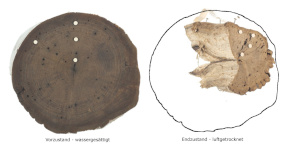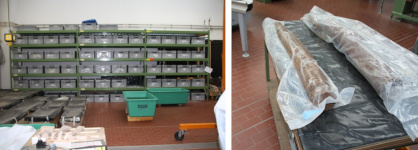Problem statement
Wood has been one of the most important materials since the earliest beginnings of human development. Its good availability, its easy workability and versatile material properties, including its use as a source of energy, have made wood an important raw material right up to the present day. However, wood "rots" in a relatively short time. In addition to animal pests, it is mainly microorganisms such as fungi and bacteria that decompose the chemical components of the wood. decompose the chemical components of the wood - cellulose, hemicellulose and lignin. In archaeological excavations in Central Europe, therefore, one usually only finds the remains of larger construction timbers as dark peaty soil discolourations. In permanently waterlogged and oxygen-poor soils, such as bogs, in groundwater areas or on river banks, timbers can also survive for archaeologically relevant periods of time. Under such oxygen-free or at least oxygen-reduced conditions, wood substance is only decomposed by anaerobic bacteria, Cellulose and hemicellulose are gradually degraded, but the lignin skeleton is often largely preserved.Water fills the damaged and weakened cells and helps to keep them in shape, and helps to keep them in shape. Darauf beruht auch der Name archäologisches Nassholz, weil das Holz komplett mit Wasser gesättigt ist. Stark abgebautes Holz kann äußerst weich sein, ähnlich wie ein vollgesogener Schwamm. So hilfreich das Wasser für die Erhaltung ist, so problematisch ist aber auch seine schadensfreie Entfernung für eine Aufbewahrung der Hölzer unter raumklimatischen Bedingungen. Aufgrund seiner hohen Oberflächenspannung wirken beim Verdunsten Zugkräfte auf die geschwächten Zellen, die zu einem irreversiblen Zellkollaps führen können. In der Folge würden die Nasshölzer bei einem unkontrollierten Austrocknen übermäßig stark schrumpfen, reißen und sich verwerfen. Alle Informationen über Form, Bearbeitungsspuren oder Alter (dendrochronologische Datierung) wären somit unwiederbringlich verloren.
When archaeological wet wood is uncovered or recovered, the first preventive conservation measures must be taken on site to prevent the objects from drying out. In most cases, the drying-sensitive timbers are deposited in water tanks or sealed in water vapour-impermeable film. However, a stable condition is not achieved by storage in water. Hydrolytic or bacterial degradation processes are not interrupted.
In order to store or present archaeological wet woods under normal room climatic conditions, conservation must take place and ensure two things:
- the removal of the water without damage to the object.
- the stabilisation of the weakened wood cells through the introduction of a strengthening agent
The methods practised today can be distinguished according to two approaches:
- Impregnation with water-soluble strengthening agents and subsequent drying
- Impregnation with water-insoluble solidifying agents with prior exchange of the water with organic solvents
After impregnation with water-soluble strengthening agents, the final drying process is of particular importance, as strong contraction forces act on the weakened cells when the water evaporates. To minimise or even eliminate this, gentle drying processes such as freeze-drying (sublimation of the water) or slow, controlled air drying (evaporation of the water), controlled air drying (evaporation with the smallest possible difference in moisture content between the surface and the inside of the wood) are used.
Before impregnation with water-insoluble strengthening agents, the water-saturated woods are dehydrated in organic solvents. Once the water has been completely replaced by solvents, the strengthening agent is applied. The advantage of this procedure is that that the solvents used have only a low surface tension and thus cannot exert strong tensile forces on the wood cells during evaporation. The dehydration takes place before the actual impregnation with strengthening agents.



